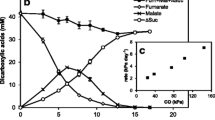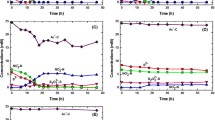Abstract
Desulfotomaculum carboxydivorans, recently isolated from a full-scale anaerobic wastewater treatment facility, is a sulfate reducer capable of hydrogenogenic growth on carbon monoxide (CO). In the presence of sulfate, the hydrogen formed is used for sulfate reduction. The organism grows rapidly at 200 kPa CO, pH 7.0, and 55°C, with a generation time of 100 min, producing nearly equimolar amounts of H2 and CO2 from CO and H2O. The high specific CO conversion rates, exceeding 0.8 mol CO (g protein)−1 h−1, makes this bacterium an interesting candidate for a biological alternative of the currently employed chemical catalytic water–gas shift reaction to purify synthesis gas (contains mainly H2, CO, and CO2). Furthermore, as D. carboxydivorans is capable of hydrogenotrophic sulfate reduction at partial CO pressures exceeding 100 kPa, it is also a good candidate for biodesulfurization processes using synthesis gas as electron donor at elevated temperatures, e.g., in biological flue gas desulfurization. Although high maximal specific sulfate reduction rates (32 mmol (g protein)−1 h−1) can be obtained, its sulfide tolerance is rather low and pH dependent, i.e., maximally 9 and 5 mM sulfide at pH 7.2 and pH 6.5, respectively.





Similar content being viewed by others
References
Armor JN (1999) The multiple roles for catalysis in the production of H2. Appl Catal A 176:159–176
Bradford MA (1976) A rapid and sensitive method for microgram quantities of protein utilizing the principle of protein–dye binding. Anal Biochem 72:245–248
Bredwell MD, Srivastava P, Worden RM (1999) Reactor design issues for synthesis-gas fermentations. Biotechnol Prog 15:834–844
Chuichulcherm S, Nagpal S, Peeva L, Livingston A (2001) Treatment of metal-containing wastewaters with a novel extractive membrane reactor using sulfate-reducing bacteria. J Chem Technol Biotechnol 76:61–68
Czuppon TA, Knez SA, Newsome DS (1995) Hydrogen. In: Bisio A, Boots S (eds) Encyclopedia of energy, technology and the environment, vol 3. Wiley, New York, pp 1752–1782
Davidova MN, Tarasova NB, Mukhitova FK, Karpilova IU (1994) Carbon monoxide in metabolism of anaerobic bacteria. Can J Microbiol 40:417–425
De Smul A, Verstraete W (1999) The phenomenology and the mathematical modeling of the silicone-supported chemical oxidation of aqueous sulfide to elemental sulfur with ferric sulfate. J Chem Technol Biotechnol 74:456–466
Du Preez LA, Maree JP (1994) Pilot-scale biological sulphate and nitrate removal utilizing producer gas as energy source. Wat Sci Tech 30:275–285
Gale J (2004) Geological storage of CO2: what do we know, where are the gaps and what more needs to be done? Energy 29:1329–1338
Janssen AJH, Dijkman H, Janssen G (2000) Novel biological processes for the removal of H2S and SO2 from gas streams. In: Lens PNL, Hulshoff Pol LW (eds) Environmental technologies to treat sulfur pollutions; principles and engineering. IWA, London, pp 265–280
Klasson KT, Ackerson MD, Clausen EC, Gaddy JL (1992) Bioconversion of synthesis gas into liquid or gaseous fuels. Enz Microb Technol 14:602–608
Klemps R, Cypionka H, Widdel F, Pfennig N (1985) Growth with hydrogen, and further physiological characteristics of Desulfotomaculum species. Arch Microbiol 143:203–208
Koros WJ, Mahajan R (2000) Pushing the limits on possibilities for large scale gas separation: which strategies? J Membr Sci 175:181–196
Lide DR (ed) (2001) CRC handbook of chemistry and physics, 82nd edn. CRC, LLC, Boca Raton, USA
Madigan MT, Martinko JM, Parker J (1997) Brock biology of microorganisms, 8th edn. Prentice Hall, Upper Saddle River, USA, pp 671–674
Parshina SN, Kijlstra S, Henstra AM, Sipma J, Plugge CM, Stams AJM (2005a) Carbon monoxide conversion by thermophilic sulfate-reducing bacteria in pure culture and in co-culture with Carboxydothermus hydrogenoformans. Appl Microbiol Biotechnol 68 (3):390–396
Parshina SN, Sipma J, Nakashimada Y, Henstra AM, Smidt H, Lysenko AM, Lens PNL, Lettinga G, Stams AJM (2005b) Desulfotomaculum carboxydivorans sp. nov., a novel sulfate-reducing bacterium capable of growth at 100% CO. Int J Syst Evol Microbiol 55:2159–2165
Perry RH, Green DW, Maloney JO (1997) Perry’s chemical engineers’ handbook, 7th edn. McGraw-Hill, New York
Pruschek R, Oeljeklaus G, Haupt G, Zimmerman G, Jansen D, Ribberink JS (1997) The role of IGCC in CO2 abatement. Energy Convers Manag 38:s153–s158
Sipma J, Meulepas RJW, Parshina SN, Stams AJM, Lettinga G, Lens PNL (2004) Effect of carbon monoxide, hydrogen and sulfate on thermophilic (55°C) hydrogenogenic carbon monoxide conversion in two anaerobic bioreactor sludges. Appl Microbiol Biotechnol 64:421–428
Sipma J, Henstra AM, Lens PNL, Lettinga G, Stams AJM (2006) Microbial hydrogenogenic CO conversion for synthesis gas purification or direct CO utilization in bio-desulfurization. Crit Rev Biotechnol 26:41–65
Stams AJM, Dijk JB van, Dijkema C, Plugge CM (1993) Growth of syntrophic propionate-oxidizing bacteria with fumarate in the absence of methanogenic bacteria. Appl Environ Microbiol 59:1114–1119
Treybal RE (1985) Mass-transfer operations, 3rd edn. McGraw-Hill, Singapore, p 33
Trüper HG, Schlegel HG (1964) Sulphur metabolism in Thiorhodaceae—I. Quantitative measurements on growing cells of Chromatium okenii. Antonie van Leeuwenhoek 30:225–238
Van Houten RT, Lettinga G (1996) Biological sulphate reduction with synthesis gas: microbiology and technology. In: Wijffels RH, Buitelaar RM, Bucke C, Tramper J (eds) Progress in biotechnology, vol 11, Elsevier, Amsterdam, pp 793–799
Van Houten RT, Hulshoff Pol LW, Lettinga G (1994) Biological sulphate reduction using gas-lift reactors fed with hydrogen and carbon dioxide as energy and carbon source. Biotechnol Bioeng 44:586–594
Van Houten RT, Yu Yun S, Lettinga G (1997) Thermophilic sulphate and sulphite reduction in lab-scale gas-lift reactors using H2/CO2 as energy and carbon source. Biotechnol Bioeng 55:807–814
Weijma J, Stams AJM, Hulshoff Pol LW, Lettinga G (2000) Thermophilic sulfate reduction and methanogenesis with methanol in a high rate anaerobic reactor. Biotechnol Bioeng 67:354–363
Zuber L, Dunn IJ, Deshusses MA (1997) Comparative scale-up and cost estimation of a biological trickling filter and a three-phase airlift bioreactor for the removal of methylene chloride from polluted air. J Air Waste Manage Assoc 47:969–975
Acknowledgments
This research was financially supported by a grant from the Technology Foundation STW (grant STW-WBC 5280), applied science division of NWO, the Netherlands, and Shell Global Solutions (Amsterdam, the Netherlands) and Paques B.V. (Balk, the Netherlands).
Author information
Authors and Affiliations
Corresponding author
Rights and permissions
About this article
Cite this article
Sipma, J., Osuna, M., Parshina, S.N. et al. H2 enrichment from synthesis gas by Desulfotomaculumcarboxydivorans for potential applications in synthesis gas purification and biodesulfurization. Appl Microbiol Biotechnol 76, 339–347 (2007). https://doi.org/10.1007/s00253-007-1028-3
Received:
Revised:
Accepted:
Published:
Issue Date:
DOI: https://doi.org/10.1007/s00253-007-1028-3




